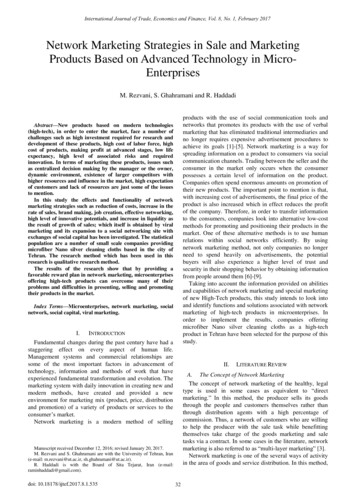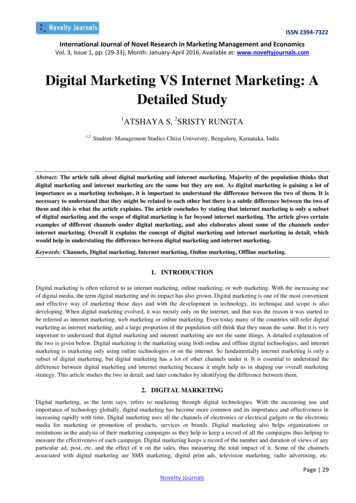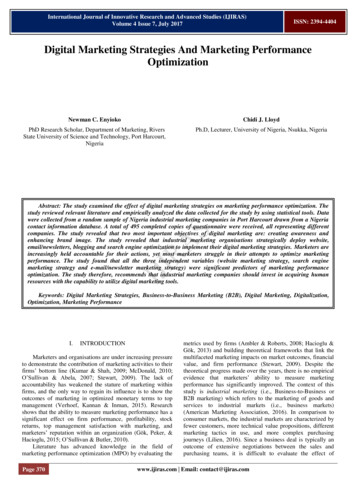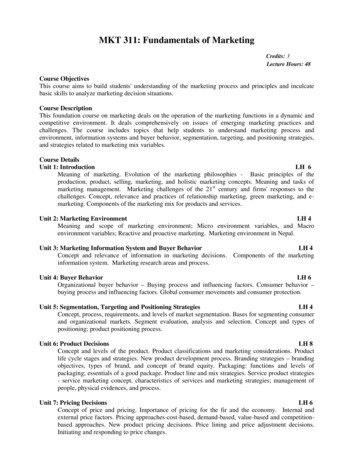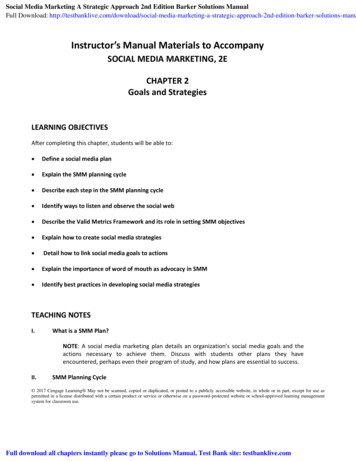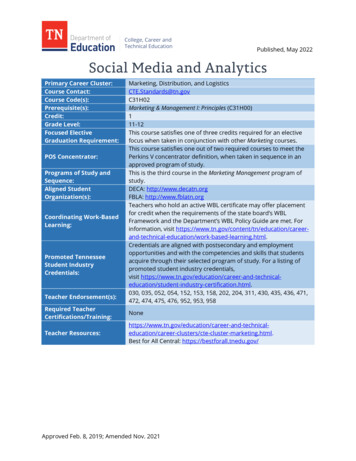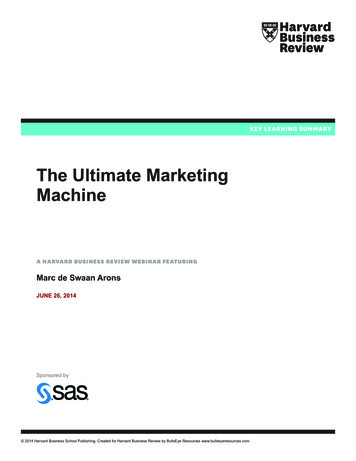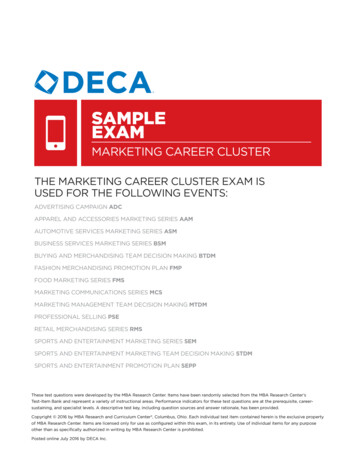
Transcription
KAAV INTERNATIONAL JOURNAL OF ECONOMICS,COMMERCE & BUSINESS MANAGEMENTKIJECBM/APR-JUN (2017)/VOL-4/ISS-2/A27 PAGE NO.194-199ISSN: 2348-4969 IMPACT FACTOR (2017) – 7.8902WWW. KAAVPUBLICATIONS. ORGMARKETING STRATEGIES OF COKE: AN OVERVIEWBY1HABIBA ABBASI1Faculty of Management And CommerceAmity University HaryanaAbstract:The Coca Cola Company, a forerunner in the infusion industry and a prominent soft drink makerfunctions in more than 200 countries and certifies 400 brands of non-alcoholic beverages. According tobusiness insider, approximately 94% of the world population is aware of the red & white logo of CocaCola. In 2004 the Company was ranked second in the world for well-designed drinks and Asian specialitydrinks. In 2016 the Company retained the third position at Interbrand's annual Best Global Brandsranking for the fourth consecutive year, with an estimated value of 73.1 billion. The current researchpaper, makes an attempt to identify and elaborate upon the strategies used by Coca Cola Company in theIndian market and also a SWOT analysis of the company has been done.Keywords: Coca Cola, SWOT, StrategiesIntroduction:The Coca-Cola Company has progress as one-man business and over the last one hundred and ten yearshas grown into one of the largest companies in the world. Dr. John Pemberton, an Atlanta pharmacist,invented Coca-Cola. He concocted the formula in a three-legged brass kettle in his backyard on May 8,1886. He mixed a combination of lime, cinnamon, coca leaves, and the seeds of a Brazilian shrub to makethe fabulous beverage .Coca-Cola debuted in Atlanta's largest pharmacy, Jacob's Pharmacy, as a five-centnon-carbonated beverage. Later on, the carbonated water was added to the syrup to make the beveragethat we know today as Coca-Cola. In the mid-1970, more than half Coca-Cola sold was outside of theU.S. Coca-Cola products outsell closest competitor by more than two to one. One in every two cola andone in every three soft drinks is a Coca-Cola product. The best-known trademark in the world is sold inabout one hundred and forty countries to 5.8 billion people in eighty different languages. This is whyCoca-Cola is the largest soft drink Company in the world. For more than 65 years, Coca-Cola has been asponsor of the Olympics. Advertisements for Coca Cola started on the radio in the 1930sand on thetelevision in 1950. Currently Coca-Cola is advertised on over five hundred television channels around theworld. For more than a century, Coke has consistently delivered the simple promise of “Coca-Cola”. Thishas enabled Coke to sustain a long track record of growth. Amidst all the years of success, the mostpivotal moments in Coke’s history came when they had to change their business dramatically. Each time,Coke’s predecessors sustained growth momentum because of three consistent factors: The Companyremained focus on the basic promise of Coca-Cola. Coca-Cola has been Coke’s consistent themethroughout the 115-year history .Coke’s leaders had the vision, foresight and the courage to innovate andadapt the mechanics of business to be enabled to thrive within the business conditions of each particularday.Copyright 2017 Published by kaav publications. All rights reserved www.kaavpublications.org194
The company left India in 1977 after the newly elected Janata Party Government came to power at theCentre for the first time. They asked the company to divest 60 % of its business and divulge its secretCoca-Cola formula. Coke preferred to quit rather than dilute its equity to 40 per cent in compliance withthe provisions of FERA .The Coca Cola came back to India after 16 years when it was launched onOctober 24, 1993, at Agra. The Godrej group, Great Eastern Shipping and the Britannia Industries Ltd,led by Rajan Pillai, initially wooed Coca-Cola. In March 1991, it signed an MOU with BIL and theChandrasekhar government accepted this proposal. But relationship between the two companies turnedsour over the export- oriented clause and finally on June 23, 1993, Coca-Cola got the permission to enterthe country with a 100 per cent unit in India. On September 22, 1993, the company bought out the Parlebrands.The various products of Coca-Cola are: Coca-Cola: The Coca-Cola is the extreme popular and foremost-selling soft drink in history,as well as the best-known product in the world. Diet Coke: The Diet Coke was born in 1982. Available in the following flavors: BlackCherry Cola Vanilla, Cola, Cola Green Tea, Cola Lemon, Cola Lemon Lime, Cola Lime,Cola Orange and Cola Raspberry. Fanta: Fanta was introduced in the United States in 1960. The positive imagery was drivenby the brand's fun, playful personality, which goes hand in hand with its bright color, boldfruit taste and tingly carbonation. Kinley: Kinley is a carbonated water that comes in wide array of variants such as tonic, bitterlemon, club soda and a myriad of fruit flavors Limca: This thirst-quenching beverage features a fresh, light lemon-lime taste and fun-lovingattitude. It's a homegrown, national treasure in India that is acquired by the Coca-ColaCompany in 1993. This drink is available in lemon flavor. Sprite: Introduced in 1961, Sprite is the world's leading lemon-lime flavored soft drink.Sprite is sold in more than 190 countries and ranks as the No. 4 soft drink worldwide, with astrong appeal to young people.Marketing Strategy of Coca ColaThe marketing strategy plays a very important role in the success of the organizations/ companies, thebasic objective being the maximization of the profit. Thus for any dealing to be conceded away thecompany would undergo a strong business research to know the strategies which should be employed inorder to run a successful business in a given society. After investigation has been done, the company ororganisation decides on the marketing strategies to be employes in order to run a successful business. Theoperative marketing approach has played a critical role for Coca Cola’s accomplishment in the worldwide marketplace. The strategies opted by Coca Cola are as under:Segmentation Strategy:The segmentation of market is a very critical approach which has to be made by keeping in mind as towhich market section to target. Market segment is a group of valuable consumers who posses exclusivecharacteristics in common. For example found within certain income range, age range, or occupationalprofile. Quite a number of these segments have been identified as more likely to patronize that productthan others. Having identified the segment, the organization would take decision whether to implementone segment or all the segments. Once the decision on which segment to use is taking, the firm can goahead and make production positioning to the segmented areas. Segmentation contributed to “niche” orspecialist market. That is, people who are more affluent or are highly place in the society demandingproduct that are of high quality and attract higher prices. Niche market supported the growth of smallfirm. This is true because large firm has found many of these segments too small to service with theexpectation of high benefits.Copyright 2017 Published by kaav publications. All rights reserved www.kaavpublications.org195
Positioning Strategy:Coca Cola has strategically positioned itself within the world soft drink market. It faces vital problem ofmaintaining its place at the same position or to adapt according to 200 countries where the brand sells itsproducts. The brand has understood this principle while ago: “thinkGlobal , act local”. Coca is willing to keep the same core product which is coke but it adapts the offer tolocal needs. They use strategic positioning in order to have the same image all around the world, which issuccess because it is perceived today as a part of daily life everywhere. This perception of the brand bythe consumers lead to a high degree of loyalty and and makes the purchasing decision more automatic.Targeting Strategy:Segmentation enables brands to define the appropriate products for different kind of customers. Coca coladoesn’t target a specific segment but adapts its marketing strategy by developing new products. Generallycoke addresses everyone it doesn’t have specific target but the focus is mainly on 12 to 30 years oldpeople, even though there is no specific product or communication for less than 12 or more than 30 , thebrand succeeds in reaching them through partnerships. India is considered to be a young country i.e.average age of Indian population is less 38years. Thus targeting young generation can be a beneficialmarketing strategy for soft drink companies.Gender based segmentation is very important. As taste of male and female is different .For exampleamong coca cola and thumps up , thumps up is promoted as masculine soft drinks while coca cola andFanta are having light taste and mainly targeted for loving birds, ladies, and children.The SWOT analysis of coke is as under:Strengths in the SWOT of coca cola are -1. Brand Equity – The Interbrand in 2011 awarded Coca cola with the highest brand equity award.Coca cola with its enormous worldwide existence and exclusive brand identity is certainly one ofthe priciest brands with the premier brand equity.2. Company valuation – One of the most valuable companies in the world, Coca cola is valuedaround 79.2 billion dollars. This valuation includes the brand value, the numerous factories andassets spread out across the world and the complete operations cost and profit of Coca cola.3. Vast global presence – Coca cola is present in 200 countries across the world. Chances are, anycountry that you go to, you will find coca cola present in that market. This vast global presence ofcoca cola has also contributed to the building of the mammoth brand name.4. Largest market share – There are only 2 Big competitors in the beverage segment – Pepsi andCoca cola. Out of these 2, coca cola is the clear winner and hence has the largest market share.Amongst all beverages, Coke, Thums up, Sprite, Diet coke, Fanta, Limca and Maaza are thegrowth drivers for Coca Cola.5. Fantastic marketing strategies – Coca cola unlike Pepsi always tries to win peoples heart.Where Pepsi’s target is continuously changing, and is targeted towards youngsters, Coca colatargets people of all ages. The targeting is also done by celebrities who are well liked – forexample – Amitabh Bacchan, Sachin tendulkar, Aishwarya Rai, Aamir Khan etc6. Customer Loyalty – With such strong products, it is natural that Coca cola has a lot of customerloyalty. The products mentioned above like Coca cola and Fanta have a huge fan following. Peoplewill prefer these soft drinks over others. Because of the good taste of Coca cola, finding substitutesbecomes difficult for the customer.7. Distribution network – Coca cola has the largest distribution network because of the demand inthe market for its products. On the other hand, due to this successful distribution network, Cocacola has been able to command such a high market presence.Copyright 2017 Published by kaav publications. All rights reserved www.kaavpublications.org196
Weaknesses in the SWOT of coca colaCompetition with Pepsi – Pepsi is a thorn in the flesh for Coca cola. Coca cola would have beenthe clear market leader had it not been for Pepsi. The competition in these two brands is immenseand Pepsi will not give up so easily.2. Product Diversification is low – Where Pepsi has made a smart move and diversified into thesnacks segment with products like Lays and Kurkure, Coca cola is missing from that segment. Thesegment is also a good revenue driver for Pepsi and had Coca cola been present in this segment,these products would have been an additional revenue driver for the company.3. Absence in health beverages – If you watch the news, you would know that obesity is a majorproblem affecting people nowadays. The business environment is changing and people are takingmeasures to ensure that they are not obese. Carbonated beverages are one of the major reasons forfat intake and Coca cola is the largest manufacturer of carbonated beverages. The inference is thatthe consumption of beverages in developed countries might go down as people will prefer ahealthy alternative.4. Water management – Coca cola has faced flak in the past due to its water management issues.Several groups have raised lawsuits in the name of Coca cola because of their vast consumption ofwater even in water scarce regions. At the same time, people have also blamed Coca cola formixing pesticides in the water to clear contaminants. Thus water management needs to be betterfor Coca cola.1.Marketing of Coca Cola in Indian MarketsAccording to Peter F Drucker , Market leadership, turnover, customer satisfaction etc are few of the manyindicators of success for a firm. The success is attributed if the product/service is technologically superiorand of good quality or an effective marketing, promotion and distribution strategy is in place. Innovativemarketing at its best can be understood from Coca-Cola India’s venture into rural India in the year 2002,with an innovative promotion and marketing strategy that differentiated it from its competitors. AtulSingh, the company’s president for India and South West Asia in an interview said “We want every partof our portfolio to grow, so that any consumer, on any occasion, anywhere in India, makes a choice todrink a Coca-Cola product”. Prior to 2002, for people in villages and small towns ‘Cola’ signified ‘PepsiCola’ and Coca-Cola India was pretty much determined to break this jinx. However, the task was not easyand there were too many issues to be addressed beforehand. Poor rural infrastructure, consumption habits(preference of traditional cold beverages -lassi and Neembu pani), awareness of the product, mercurialelectric supply and apprehension among shopkeepers added to Coca-Cola India’s dilemma. It started itsrural campaign with strategy focused around three A’s of marketing. Availability The centralizeddistribution system of transporting the product directly from the bottling plants to retailers, as used inurban market was futile for rural market which resulted in innovative “Hub and spoke” distributionsystem. The stock was transported from the bottling plants to hubs and then from hubs to spokes (situatedin small towns) and from spokes to retailers who catered to the demands in rural areas. A well designedmarketing strategy with strong and efficient supply chain and logistics ensured Coca-Cola’s presence withincrease in coverage of 81,383 villages in 2001 to 1,58,342 villages in August 2003.Copyright 2017 Published by kaav publications. All rights reserved www.kaavpublications.org197
AffordabilityAccording to the survey conducted in 2001 by the company it was exposed that 300 ml bottle which waspriced at Rs 10/- was not so famous with rural and semi-urban price sensitive customers. To overcomethat Coca-Cola launched 200 ml bottles (Chota Coke) priced at Rs 5/- . Coca-Cola achieved affordabilityby economies of scale. Then the next big task at hand was increasing brand awareness among the targetsegment in rural areas.AcceptabilityCoca-Cola backed up its pricing and distribution by extensive marketing in the mass media and outdooradvertising. Hoardings with painted name Coca-Cola on the compounds of the village residence,participation in annual haats and television commercials (TVCs) on Doordarshan were all set to markCoke’s presence in a big way. TV commercial for North Indian people referring Coca-Cola as ‘thanda’was flooded on television with Amir Khan as brand ambassador. Progressive advertising ensured easybrand recall and top of mind awareness among customers. Judith Evans pointed out, “Travel where youwill, anywhere in the world, and you will encounter Coca-Cola — on clothes, in signs, on packaging, inart — everywhere.” Market has encountered lot of innovation in terms of products, packaging, equipmenthandling, marketing etc, but the way in which Coca-Cola adopted its strategy for the Rural Indian marketwas remarkable and it definitely established Coca-Cola as life’s one of the most delightful elixirs.Conclusion:The Coca-Cola Company is the leading soft drink maker nationally and globally. It has set itself far apartfrom its competitors by building a solid foundation of consumers since 1896. The Coca-Cola Company’smarketing machine continues to come up with new, exciting, and innovative ways to keep customersreturning. The strategies that helped coca cola company to won the attention of the consumers to herproducts include; constant promotion of the products, continuous business of sales promotion activities,the production of standard products, provision of after sale services, obeying law and political structure ofthe country, introduction of disposable bottles of coca cola, charging of affordable prices for theirproducts. Also the company has effectively been able to execute the concept of marketing along withestablishing a solid marketing mix. Combine all of the aforementioned with their strong presence in thecommunity; the Coca Cola Company has a recipe for success.Copyright 2017 Published by kaav publications. All rights reserved www.kaavpublications.org198
References:1. oca-cola/2. oca-cola-did-it-in-india/3. Adromida (2011) sales promotion/marketing mix strategy and ideas and method (online):available at:http://andromida.hubpages.com/hub/co.4. Belch G.E. and Belch, M. A (2007) Advertising and Promotion. An integratedmarketing communications perspective. Seventh edition.5. Bennett, R (1998 1). International Marketing Strategy, Planning, Market entry andImplementation. Second edition.6. Cateora, P. R and Graham, J. L (2007) International Marketing. Thirteenth edition7. Chartered Institute of Marketing (2011) Marketing Planning Tools. (Online): availableat: http://www.cim.co.uk/marketing planning8. d/coca-cola-no-3-on-mostvaluable-brands-ranking9. feeling-launch10. g-strategy/11. ijom/article/view/37337Copyright 2017 Published by kaav publications. All rights reserved www.kaavpublications.org199
The SWOT analysis of coke is as under: Strengths in the SWOT of coca cola are-- 1. Brand Equity - The Interbrand in 2011 awarded Coca cola with the highest brand equity award. Coca cola with its enormous worldwide existence and exclusive brand identity is certainly one of

